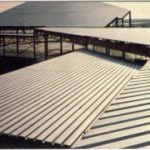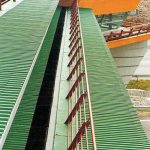Mild Steel
Property


Constituents
The term ‘steel’ usually refers to plain carbon steel, defined as alloys of iron and carbon that do not contain more than 2% carbon and are malleable in block and or ingot form.
Steel will have chemical composition containing:
- Carbon: 0.16-0.25%
- Manganese: 1.5-16%
- Silicon: 0.1-0.5%
Grade
According to BS 4360: 1990
| Grade | Ultimate Tensile Strength (MPa) |
| 40 | 340-500 |
| 43 | 430-580 |
| 50 | 490-640 |
| 55 | 550-700 |
Source: Doran, DK; Newnes Construction Material – Pocket Book; Butterworth- Heinemann Ltd; Oxford; 1994 [2]
Carbon Content and Properties
Carbon amounts up to 0.8% increases strength with each increment of carbon added and decreases ductility in the same proportion. Hardness also increases with greater carbon content.
For structural purposes, steel needs carbon to give strength but not in such quantity as to affect ductility.
| Type of steel | Carbon percentage | Ultimate Tensile Strength (MPa) | Yield Tensile Strength (MPa) |
| Very mild | 0.05-0.15 % | 275.80-379.23 | 165.48-206.85 |
| Mild | 0.15-0.25% | 303.96-448.18 | 206.85-248.22 |
| Low-carbon | 0.25-0.40% | 413.70-482.65 | 248.22-275.80 |
| Medium carbon | 0.40-0.65% | 482.65-551.60 | 275.80-303.96 |
| Higher carbon | 0.60-0.70% | 551.60-648.13 | 303.96-386.12 |
| Spring | 0.70-0.80% | 648.13-813.61 | 386.12-441.28 |
| Pearlitic | 0.75-0.85% | 827.4 | 482.65 |
Classification
Both cast and wrought carbon steel have been generally classified into approximate grades base on the carbon content:
| Ingot Iron | Lowest possible content of carbon and other alloying elements, made in basic open-heart furnaces, corrosion resistant, used largely for sheet. |
| Extra soft or Dead soft steel | 0.08-0.18% carbon, this type of steel is characterized by ductility, toughness, weldability, and is used where cold-workability is desirable; generally it is used where strength or stiffness is not important. |
| Mild, structural steel | 0.15-0.29% carbon; characterized by strength combined with easy machinability, used for buildings, bridges, bolts, boilers, railroadrolling stock. |
| Medium grade | 0.25-0.35% carbon; harder and stronger than mild structural grade yet can be hot-forged; used for shipbuilding and machinery. |
| Medium hard grade | 0.35-0.65% carbon |
| Spring grades | 0.85-1.05% carbon |
| High carbon tool steel | 1.05-1.20% carbon |
Manufacturing Process [2]
Casting
Most steel compositions can be cast directly into complex shaped components. The casting is usually heat treated to relieve any residual stresses caused by uneven cooling and to refine the grain structure of the material.
Rolling
Rolling is the most widely used process; it can be done hot or cold. A wide range of cross sectional shapes can be produced
Forging
Hot forging is used to make shaped, usually blocky, artefacts which need to have properties better than those of casting.
Seamless tube forming
Seamless tubing is produced by hot deformation of initially cylindrical billets. Rolls which generate a spinning motion about the billet axiz as well as motion along the billet axis are used to force the billet around a mandrel which defines the internal diameter of the tube.
Drawing
In wire drawing, a feedstock is pulled through a die by the product. If the material did not work harden, the process would not work. Successive reductions through many dies can be used to impart very high strength by work hardening. The price paid is reduction in ductility and toughness.
Finishes
Hot dipping, electro galvanizing, spraying and sherardizing are all processes whereby a protective coat of zinc is applied to steel and iron to seal them against corrosion.
Galvanized sheets that are heat-treated after coating produce a zinc-iron alloy surface free of spangles and is suitable for painting after cleaning. Where severe corrosive conditions exist, it is advisable to protect galvanized steel with paint.
Galvanizing
Galvanizing is the application of a coating of zinc to steel products for protection against many types of corrosion. The coatings are measured in g/m² and vary from 275 to 915.45 g/m² for sheet products; and 91.55 to 475.73 g/m² for surface for wire and prefabricated products.
The advantage of the coating with zinc is that, should the iron and steel become exposed through wear, aging, or discontinuities such as pinhole in the coating, galvanic reaction between coating and base metal causes the zinc to corrode and form compounds that cover and continue to protect the iron and steel for as long as any zinc remains.
Density and Thermal Properties
| . | Density at 20ºC (kg/m3) | Coefficient of thermal expansion x 10-6 /ºC | Thermal Conductivity (W/mK) | Specific Heat (J/ kgK) |
| Pure Iron | 7870 | 12.1 | 78 | 455 |
| Wrought low carbon steel | 7860 | 12.2 | 65 | 480 |
| Cast low carbon steel | 7860 | 12.2 | 49 | 480 |
| Medium carbon steel | 7850 | 12.2 | 51 | 485 |
| High carbon steel | 7850 | 11.1 | 48 | 490 |
Source: Doran, DK; Newnes Construction Material – Pocket Book; Butterworth- Heinemann Ltd; Oxford; 1994 [2]
Elasticity
Modulus elasticity of mild steel:
- 0.75% C: 210 GPa
- 1.0% C, 1.0% Mn, 0.65% Cr, 1.0% W (hardened): 200-205 GPa
Tensile Strength
Hot rolled steel: tested in accordance with BS EN 10002-1, has an ultimate tensile strength in the range 355 to 510 MPa.